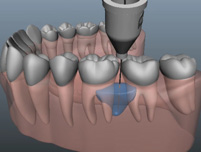
Adult Dental Anesthesia
Dental anesthesia
Dental pain can sometimes be severe and difficult for patients to manage. The fear of pain can sometimes be even stronger, and 54% of patients experience feelings ranging from simple apprehension to deep phobia. Today we have a complete arsenal (dental anaesthesia, conscious sedation), allowing us to act both in the prevention and treatment of pain and anxiety.
1. Drug treatments
A. Painkillers
For mild pain, simple painkillers such as paracetamol are usually sufficient. The effective dosage is 1000 mg every 6 hours, if there are no contraindications.
B. Anti-inflammatory drugs
For more severe pain, or if paracetamol is ineffective, the prescription of anti-inflammatory drugs such as ibuprofen or mefenamic acid often gives better results than paracetamol. It also helps to reduce post-operative side effects (oedema or trismus), although these depend to a large extent on the type and duration of the operation.
C. Anxiolytics
Stress and fatigue are aggravating factors for many patients. The goal is to obtain the physical and psychological comfort of the patient in order to facilitate the realization of the care.
The molecule of choice will be hydroxizine (ATARAX ©) or a benzodiazepine like Valium ©. The prescription of anxiolytics in anxious patients allows a better efficiency of painkillers and anti-inflammatory drugs, as well as of the anaesthesia, which allows to reduce the postoperative effects.
The disadvantage of anxiolytics is the duration of their action. They require to be accompanied and it is strongly advised not to drive a vehicle on the day of the operation.
2. Local anaesthetics
To avoid feeling pain during an operation, the dentist injects a solution that stops all pain. If today many interventions can be done without anaesthesia thanks to the progress of the technique, some patients prefer to have a systematic anaesthesia for their comfort during the intervention. The techniques differ
depending on the tooth treated and the type of procedure, with variable side effects. In any case, these are rare and temporary (hematoma, numbness of the cheek and lip for a few hours).
The sensation of the injection is also minimized thanks to the use of specific equipment. In particular, we use a pre-anesthetic gel to massage the gums prior to the injection.
Dentist with local anesthesia
A local anaesthetic stops the excitability of sensitive nerve fibres, in a temporary and reversible way. It therefore allows the pain to be inhibited for a given time.
In the formula used, we find the local anesthetic: it is one of the molecules ending with the suffix "-caine" like lidocaine or ropivacaine, more modern.
In addition to the anaesthetic, there is adrenaline for its vaso-constrictor effect, which will reduce bleeding, increase the concentration of the product locally and prevent its spread to neighbouring areas, thus allowing a longer time of action.
Dental surgeons are trained to know exactly where to prick for each type of dental procedure, because it is a matter of more or less localized numbness, and of numbing this or that type of nerve.
Methods and support for a better experience of the intervention
Methods have been worked on to accompany the patient both in his anxiety about the injection but also in the pain it may cause:
-
Pre-anaesthesia or surface anaesthesia
It is indicated for children and very anxious patients. The mucous membrane is anaesthetised before the injection, either by using an anaesthetic spray or gel at the site where the injection is to be made, or by using a cryogenic spray (which causes intense localised cold) to block sensitive receptors in the mucous membrane.
-
Osteo-central anesthesia (Quicksleeper)
It is an interesting alternative. Based on the injection of the anaesthetic into the cancellous bone surrounding the tooth, it uses the blood flow within the Volkman canals to diffuse both mesially and distally. Because of the low diffusion to the mucous membranes, soft tissue anesthesia is very rarely present, which avoids disturbing younger children and removes the risk of self-biting so common with infiltration techniques. In children, the bone cortex is thin and its passage is done by simple pressure and without pain.
With QuickSleeper, all your anaesthesias are quick, painless, without the stress of failure or post-operation after-effects.

The anesthetic is:
- immediate
- unscathed
- without numbness
- without lingual or palatal recall
3. Conscious sedation techniques
A. MEOPA or nitrous oxide
Nitrous oxide is used in anxious patients for its analgesic, sedative and anesthetic properties.
It is effective on small pains (thanks to it, one does not feel the pain of an injection, or the sensitivities related to a scaling). It allows the patient to relax, and its amnesia effect allows not to remember the intervention.
A one-hour session often seems to last between 20 and 30 minutes.
The advantage of MEOPA is its rapidity of action, it acts after 2 to 3 minutes of inhalation. In the same way, its effect dissipates quickly and the patient can leave alone, driving his vehicle if necessary.
Possible side effects are nausea/vomiting, dizziness, and excitement.
B. Intravenous sedation
Intravenous conscious sedation is a technique consisting of the injection of one or more drugs into the vein to reduce the consciousness of the patient undergoing a dental procedure. The patient remains conscious, responding to stimuli and questions from the dentist.
The advantages of intravenous sedation are its effectiveness (over 99.99% success rate) and safety. The amnesia it provides the patient is real, and the recovery time is shorter than with oral anxiolytics, but the patient must be accompanied.
The disadvantages are the need for an infusion, which may be difficult for some patients to accept, and the need for more monitoring than with other methods.
4. General anaesthesia in dental practice
Dental care for people with disabilities
General anaesthesia is possible in the case of major surgery, a long operation or for disabled patients or those with certain pathologies.
Dentist with general anesthesia
The anaesthesia is performed by a physician-anaesthetist, but the procedure is ambulatory, i.e. it does not require an overnight stay.
This type of anesthesia renders the patient unconscious and insensitive to pain. The procedure can last up to 2 hours for children and 4 hours for adults. A rest period of about 45 minutes follows. The patient must always be accompanied, and remain so throughout the day.
The risks associated with general anaesthesia are nausea, headaches, momentary disorientation, and haematomas at the injection site. Important decisions (contracts to be signed, legal decisions) should be avoided for 24 hours. In rare cases, general anaesthesia can be followed by serious, life-threatening complications. This is why they are carried out under the supervision of a resuscitating anaesthetist, with monitoring of the patient.


